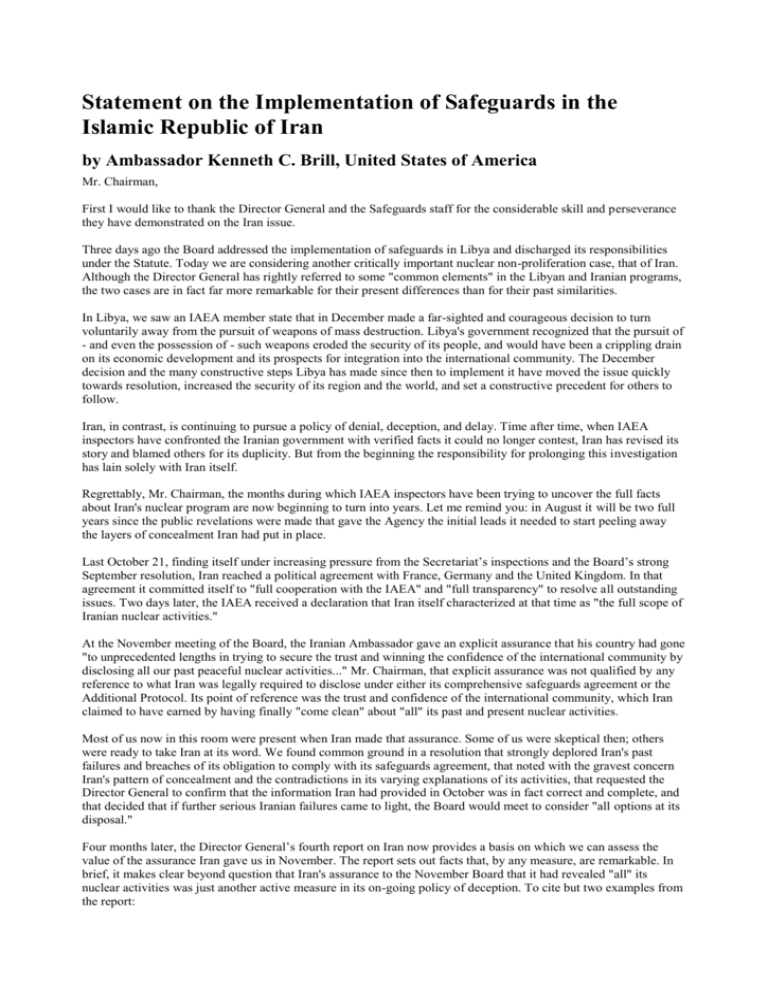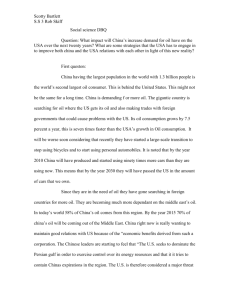Statement on the Implementation of Safeguards in the Islamic
advertisement

Statement on the Implementation of Safeguards in the Islamic Republic of Iran by Ambassador Kenneth C. Brill, United States of America Mr. Chairman, First I would like to thank the Director General and the Safeguards staff for the considerable skill and perseverance they have demonstrated on the Iran issue. Three days ago the Board addressed the implementation of safeguards in Libya and discharged its responsibilities under the Statute. Today we are considering another critically important nuclear non-proliferation case, that of Iran. Although the Director General has rightly referred to some "common elements" in the Libyan and Iranian programs, the two cases are in fact far more remarkable for their present differences than for their past similarities. In Libya, we saw an IAEA member state that in December made a far-sighted and courageous decision to turn voluntarily away from the pursuit of weapons of mass destruction. Libya's government recognized that the pursuit of - and even the possession of - such weapons eroded the security of its people, and would have been a crippling drain on its economic development and its prospects for integration into the international community. The December decision and the many constructive steps Libya has made since then to implement it have moved the issue quickly towards resolution, increased the security of its region and the world, and set a constructive precedent for others to follow. Iran, in contrast, is continuing to pursue a policy of denial, deception, and delay. Time after time, when IAEA inspectors have confronted the Iranian government with verified facts it could no longer contest, Iran has revised its story and blamed others for its duplicity. But from the beginning the responsibility for prolonging this investigation has lain solely with Iran itself. Regrettably, Mr. Chairman, the months during which IAEA inspectors have been trying to uncover the full facts about Iran's nuclear program are now beginning to turn into years. Let me remind you: in August it will be two full years since the public revelations were made that gave the Agency the initial leads it needed to start peeling away the layers of concealment Iran had put in place. Last October 21, finding itself under increasing pressure from the Secretariat’s inspections and the Board’s strong September resolution, Iran reached a political agreement with France, Germany and the United Kingdom. In that agreement it committed itself to "full cooperation with the IAEA" and "full transparency" to resolve all outstanding issues. Two days later, the IAEA received a declaration that Iran itself characterized at that time as "the full scope of Iranian nuclear activities." At the November meeting of the Board, the Iranian Ambassador gave an explicit assurance that his country had gone "to unprecedented lengths in trying to secure the trust and winning the confidence of the international community by disclosing all our past peaceful nuclear activities..." Mr. Chairman, that explicit assurance was not qualified by any reference to what Iran was legally required to disclose under either its comprehensive safeguards agreement or the Additional Protocol. Its point of reference was the trust and confidence of the international community, which Iran claimed to have earned by having finally "come clean" about "all" its past and present nuclear activities. Most of us now in this room were present when Iran made that assurance. Some of us were skeptical then; others were ready to take Iran at its word. We found common ground in a resolution that strongly deplored Iran's past failures and breaches of its obligation to comply with its safeguards agreement, that noted with the gravest concern Iran's pattern of concealment and the contradictions in its varying explanations of its activities, that requested the Director General to confirm that the information Iran had provided in October was in fact correct and complete, and that decided that if further serious Iranian failures came to light, the Board would meet to consider "all options at its disposal." Four months later, the Director General’s fourth report on Iran now provides a basis on which we can assess the value of the assurance Iran gave us in November. The report sets out facts that, by any measure, are remarkable. In brief, it makes clear beyond question that Iran's assurance to the November Board that it had revealed "all" its nuclear activities was just another active measure in its on-going policy of deception. To cite but two examples from the report: When Agency inspectors confronted Iran in January 2004 with new information, it had to admit it had failed to declare the more advanced P-2 centrifuge design drawings and associated research and testing, and indeed that it had not previously acknowledged even the existence of the P-2 program. If Agency inspectors had not followed up leads discovered during their work in Libya, there is no reason to believe Iran would have declared the P-2 program at all. I can only echo both the DG's expression of "serious concern" about that concealment and his judgment that the explanations Iran has offered to date are "difficult to comprehend." Inspectors also had to discover for themselves that Iran had carried out experiments to produce polonium 210, a rare and toxic material that can serve as a neutron initiator in nuclear weapons but has very few civilian applications, none of which is plausible in the Iranian context. Again, Iran has not been able to document or otherwise persuasively explain why it conducted that work. In the face of this demonstration that the assurances Iran gave in October and November were not fulfilled, it is not surprising that today we have heard Iran try to explain away its previous assurances and retroactively to redefine different commitments. The record, however, is clear. The DG's report also detailed numerous cases in which information that Iran provided in explanation of its nuclear activities turned out, once again, to be either not complete or not persuasive. One such issue still lacking a credible explanation is why one room at the Kalaye Electric Company was contaminated with uranium enriched to the 36 percent level. Indeed, the broader question of how the evidence of nuclear activity in Iran confirmed by environmental sampling can be squared with Iran's assurance that it never enriched uranium to more than 1.2 percent - an assurance that itself, I would remind you, was "in contrast" to Iran's initial insistence that it never had enriched uranium at all. That issue continues to pose a challenge both to Agency inspectors and to the broader international community. Paragraph 75 of the DG's report indeed indicates that the enrichment issue remains "the major outstanding issue" the Secretariat is facing, despite all the intensive work it has done on that subject since last summer. It is therefore all the more extraordinary, Mr. Chairman, that the report had to note that "the Agency is still waiting for Iran to provide requested information" not only on the origin of the centrifuge equipment and components, but even on "the locations in Iran to which such equipment and components were moved and the associated details of timescales, and the names of individuals involved." As the months pass, the Board must once again ask whether it can really be so difficult for Iran to provide the information the Agency needs to finish its investigation. We must consider whether the real reason for the continuing delays is the same reason why last year Iran refused for months to allow environmental sampling at the Kalaye Electric Company, while it was carrying out extensive modifications intended to prevent the Agency from verifying the activities previously conducted there. Is it possible that, even as we meet, squads of Iranian technicians are working at still-undeclared sites to tile over, paint over, bury, burn or cart away incriminating evidence so that those sanitized locations can finally be identified to the Agency as new evidence of Iran's full cooperation and transparency? Is it possible that nuclear activities are continuing at facilities Iran has no intention of declaring? I call to your attention, Mr. Chairman, the facts that the DG's report revealed about the manufacturing of centrifuge components in military-industrial workshops. We commend the Agency for its conscientious pursuit of the truth about Iran's nuclear program, including the extent to which that program involves the Iranian military. In a country like Iran, with a sophisticated and well-capitalized energy sector, it is more than curious that a nuclear program said to be purely civilian in nature and purely for power generation purposes - seems to have much closer ties to the Iranian military than it does to the rest of the civilian energy sector. We look forward to learning whether Iran's forthcoming declarations under the Additional Protocol clarify the nature and extent of military involvement in the Iranian nuclear program. The Agency should also follow up on any indications A. Q. Khan could have provided nuclear weapons design information to Iran. I might note that the Iranian delegation’s willingness to support only those things in the Director General’s report that it agrees with and to question or denigrate the many Iranian shortcomings and problems the report details speaks volumes about Iran’s true attitude to the Agency’s work. The United States hopes that a robust implementation of the Additional Protocol in Iran will help throw muchneeded light on those and other issues. In that connection, however, I am sure all Board members were troubled by the recently reported public statement by a high Iranian government official that in addition to the P-2 advanced centrifuge program, Iranian experts are engaged in other types of research that Iran has not reported to the IAEA and does not intend to report. Such statements hardly increase the confidence of the international community in the strength of Iran's commitment to its safeguards agreement and to the Additional Protocol. Mr. Chairman, the U.S. supported the efforts of France, Germany and the United Kingdom announced last October to reach an accord with Iran on an internationally verifiable suspension and then cessation of Iran's enrichmentrelated and reprocessing activities. We said at the time that such actions by Iran, combined with full, verifiable transparency, would be the best way for it to build international confidence regarding the nature of its nuclear program. However, we have witnessed Iran, through its actions and its repeated public statements, making a mockery of that agreement. Far from suspending all enrichment-related activities on the path to cessation, Iran continued until January to manufacture, assemble and test centrifuges, and continued construction at the massive Natanz site. In addition, we are concerned that Iran's February announcement - that it will suspend centrifuge assembly and testing, as well as component manufacture "to the furthest extent possible" - may represent another tactical diversion, and that Iran may intend to continue its programs in defiance of the Board's resolutions. In that regard, we are deeply troubled by statements made by senior officials in Tehran - issued at almost the same time Iran was announcing a new commitment to suspend its assembly of centrifuge components - to the effect that Iran intends to produce and export nuclear fuel to world markets, and more recent statements that Iran "definitely" intends to resume its enrichment activities "when our relations with the IAEA return to normal." We also find difficult to comprehend what commercial obligation could outweigh a sovereign decision by Iran to suspend domestic manufacture of centrifuge components - manufacturing that, as the Director General has reported, is taking place mostly at military-controlled workshops. One must ask whether Iran sees suspension and cessation as a route to better relations with the world community, or merely as a short-term maneuver intended to avoid a Board report to the UN Security Councilor other criticism by the Agency. The fact that, after months of resistance, Iran's latest partial step on suspension came only at the last possible minute before the Director General's February 24 report, speaks volumes. Whatever Iran's motivation may be, the Board must adopt at this meeting a resolution that makes clear, as did our resolutions in September and November, that only a prompt and comprehensive suspension of all enrichment-related and reprocessing activities can begin to build international confidence in Iran's intentions after the breaches, failures an deception that have come to light over the past year. We again urge Iran to respond positively and fully to the Board's concerns on the suspension issue. The resolution the Board adopted today makes no definitive judgments, but it makes clear Iran has yet to discharge the obligation of full cooperation, compliance and transparency essential to the fulfillment of its legal commitments, not to mention its more recent political commitments. That clear statement of the facts is common ground on which we all stand. As our resolution says, the Board will consider in June how to respond to Iran’s omissions of important information, as well as other relevant issues. But although Iran continues to press in Vienna and in many capitals for its "file" to be closed in June, there is no indication the work of the Secretariat, of the Board, will have been completed by that time. No member of the Board should lend any support to efforts to impose artificial restrictions on the authority and responsibility of the Board and the Secretariat to perform their duties under the Statute and safeguards agreements. Surely doing so would be inconsistent with our responsibilities as members of this Board. Libya has now demonstrated, Mr. Chairman, that a country genuinely committed to reversing course can move swiftly and pro-actively to eliminate weapons of mass destruction programs. In Iran's case, in contrast, we regret that once again, as at every Board meeting over the past year, Board members find it necessary to call on Tehran to intensify its cooperation with the Agency, as the Director General urged in his latest - but not last - report. The "Iran file" at the IAEA cannot and will not be closed until all the facts are known and an appropriate finding of the Board is made upon them. Mr. Chairman, that concludes the statement I had intended to deliver today. But in light of the very troubling news reports over the past 24 hours about Iran’s sudden decision to halt inspections for at least a number of weeks - and the Iranian delegation’s less than subtle hints today that Iran’s cooperation with the Agency has conditions attached to it - I think Board members would benefit from information from the Secretariat about what impact that decision may have on the inspectors’ work. Can the Secretariat tell us whether the inspections that were postponed were essentially routine inspections, or were inspectors planning to visit new sites or facilities? Has Iran said how long the postponement will last? How will the delay affect inspection plans and schedules? Especially in light of Iran’s past record of carrying out sanitizing "modifications" to sites before allowing inspectors to carry out environmental sampling, could such a postponement potentially provide time for work that would affect the inspectors’ ability to address all relevant outstanding issues and draw closer to conclusions about the Iranian nuclear program? Finally, I note the Agency circulated the Iranian written response to the Director General’s February 24 report, which, as far as we can tell, duplicates the oral presentation the Iranian delegation made during Deputy Director General Goldschmidt’s technical briefing - and indeed we have heard yet another exposition of this information today in Iran’s statement. My delegation, and I’m sure other delegations, would appreciate receiving the Agency’s written reaction to Iran’s continued assertions that the Director General’s report is full of mistakes. Thank you, Mr. Chairman.








